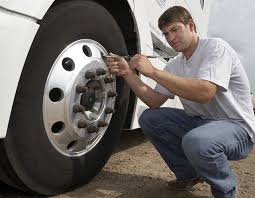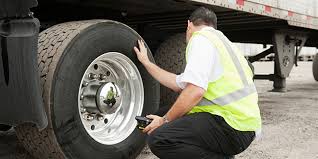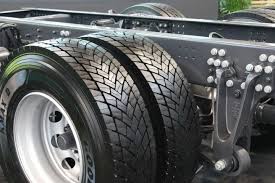Important Things to Know About Commercial Truck Tires
Heavy duty truck tire information
Tires are critical vehicle components because they connect trucks and trailers to the road and allow drivers to steer safely on diverse terrains. Since they play such an important role in vehicle operation, it can be beneficial for drivers to understand how to prevent wear and tear. Learn more about tire components and get helpful maintenance tips.
What the sidewall information means
Information such as the Tire Identification Number (TIN), ply material, and Tire Performance Criteria Specification (TPC Spec) are labeled on the sidewall. You can also find the tire size — a combination of numbers and letters that describe the:
- Section width. A three-digit number that measures (in millimeters) the tire’s outermost most edge to its innermost edge.
- Sidewall aspect ratio. This indicates the sidewall’s height from rim to tread as a percentage of the section width. For example, if the number is 70, that means the height is 70 percent of the tire’s width. The bigger the number, the taller the sidewall. The smaller the number, the shorter the sidewall.
- Type of construction. There are two types of tire construction — radial and bias-ply. An uppercase R indicates radial tires. A tire labeled with an uppercase B or D represents bias-ply tires.
- Rim diameter. The number indicating the size (in inches) of the wheel that fits the tire.
- Service Description. The service description includes the load index and speed rating. The load index specifies the maximum carrying capacity of the tire. The speed rating indicates the top speed a properly installed tire can reach.
Tire maintenance and safety tips
Driving on worn-out or damaged tires is dangerous and is against Federal Motor Carrier Safety Administration (FMCSA) rules. If a truck driver is caught driving on unsafe tires, the FMCSA will assign points that can majorly impact a carrier’s CSA score. Avoid violations and poor CSA scores by following these tips to keep your tires in good shape:
- Perform a pre-trip inspection
- Inflate to recommended PSI
- Wash the tires and wheels
- Get tires rotated regularly
- Practice good driving habits

4 Inch vs. 6 Inch Lift Kit
Any lift kit turns a truck into a piece of beauty – the only issue here is that there are a lot of them out there to choose from, and that my friends makes the whole selection process fairly complicated.
On this post i will be talking about probably the most common, i.e. 4 and 6 inch kits, and guide you through on what to actually go for, from my perspective.
4 inch pros
Fits in more spots
Because the pickup isn’t lifted as high, you will be able to access more places. By that i mean garages, parking spots, car washes, etc.
This may sound stupid at first, though i can tell you that there are a ton of people who go exactly for the shorter lift because of this reason – think about it, if the thing can’t fit in the garage, where are you going to put it?
Ease of use
It’s going to take less effort to access a pickup truck that is lifted only by 4 inches, literally.
Again, this might sound weird at first, but if you’re going to be getting in and out of the cab or the bed all the time, you’re going to thank me that you went this route.
Less severe on the fuel consumption
Now i know that truck owners, especially those who already think of lifting one, probably aren’t really concerned about this, but still.
A 6 inch lift kit would require larger tires than a 4 to make the whole deal look proper, and as we all know, the bigger the tire the more power needs to be generated in order to drive it, hence the decrease in fuel economy.
Generally less expensive
The cost comes from the fact that the pickup won’t need to sport larger tires, that is, a 33 inch tire will definitely be a bit more affordable than the 35’s.
6 inch pros
More off-road
A vehicle raised by 6 inches instead of 4 inches will sit on a higher level, therefore be able to perform better in not-so-favorable conditions, even more so if it’ll have taller tires installed.

What Factors Can Cause Damage to the Tires?
Many people ask “How long do tires last on average?“
The problem is, there’s not a set answer to that question – due to the variety of factors that can lead to a necessary tire replacement. These factors include:
- Tire design from the manufacture ( some tires are built to last 70,000 miles and other are 40,000 miles so they will have very different time in use )
- A lack of attention to basic tire maintenance (checking the air pressure, tire rotations, alignment, visible wear, etc.)
- Not using the right tires for different seasons and terrains.
- Potholes, obstacles, curbs, sharp objects, and speed bumps
- Climate conditions (extreme hot or extreme cold can accelerate wear and tear)
- Excessive braking
- Driving for long periods at high speeds

What You Need To Know When Choosing Aftermarket Wheels For Your Truck
Choosing Wheels For Your Truck
Since the opening of iDrive, we have built thousands of custom trucks. One of the first things we do is pick out what kind of wheel set up we are going to do on a particular truck. The three main things that we consider when choosing our wheels are: 1. Diameter/wheel size, 2. Width, and 3. Offset. These factors are very important to consider because if we decide to do a lift or a level we will be able to determine what wheels and tires will fit. On the other hand if we are going for a specific look, like a pre-runner look we know that we need to go with a smaller wheel with a high (positive or zero) offset so we can fit bigger tires. The other extreme would be a really “stanced” look, where the wheels poke out beyond the fenders. With that look, we know that the wheel is going to have a low (negative) offset and be wider than a standard aftermarket wheel.
Wheel Diameter (Size)
The size of the tire is the first thing we need to figure out. The truck example we will use for this article is an F-150 (these dimensions will change if you go to other half tons or ¾ and 1 tons). If you are planning on doing a level kit on an F-150 (or other half ton) we know that we can fit a 33” tire. If you’re going for a pre-runner/more off road look then the wheel will likely be anywhere from 16”-18” so that the sidewall of the tire is thicker. If you’re going for the “stanced” look then chances are you are going with a 20”, 22”, or 24″ wheel.
When lifting a truck, you will have many more options. We sometimes will stick to an 18” wheel and put on 35” or even 37” tires depending on the size of the lift to get a really “beefy” look. On the other hand, if we have a lift we can also squeeze bigger wheels. 24” wheels are typically the biggest that we do, but you could potentially go with a 26” if the lift is big enough, but typically the width will also increase so that is another factor to consider which we will discuss next.
Wheel Width
Standard widths go as follows: 18” diameter with a 9” width, 20” diameter with a 10” or 12” width, 22” diameter with a 10” or 12” width, 24” diameter with a 12” or 14”. These are just standard sizes, there are a few more variations, but these are the main sizes that consumers will see. There isn’t much variation with smaller wheel sizes, but when you go up to a 20” wheel then the option of going to a 12” wide is available to achieve a stanced look.
Jacked Up Truck Tires and Your Transmission
If you’re thinking about putting some nice big tires on your lifted truck, keep in mind that you must make serious changes to your transmission. Strangely, most people I’ve known who have installed monster truck tires on their lifted truck don’t make these changes. The result? They keep killing their transmissions and spending a fortune in repairs.
So when you start planning that lifted truck with an eye on some nice big tires, keep in mind you will also need to budget the appropriate transmission adjustments. Big tires kill transmissions… unless you appropriately modify the transmission in advanced for the size and weight of the new tires. And I hate to break it to you, but this transmission job ain’t cheap. So before you finish budgeting what type of lift kits you can afford, make sure you include the transmission adjustment as part of that budget.
This is also something you should keep in mind when you evaluate used jacked up trucks or any jacked up trucks for sale you find on the market. If they have larger tires than the manufacturer recommends or than what comes with the original vehicle, you need to find out if they’ve made the appropriate transmission torque ratio adjustments. If not, you’ll just be buying a 4×4 truck with a dying transmission.